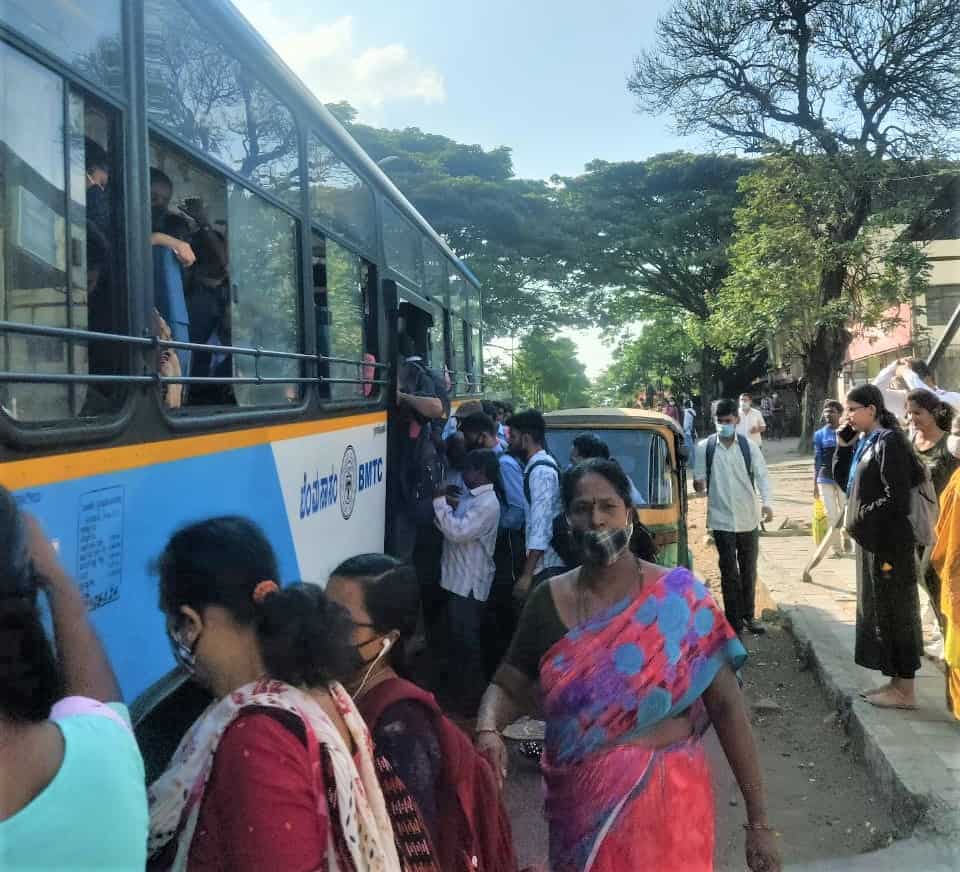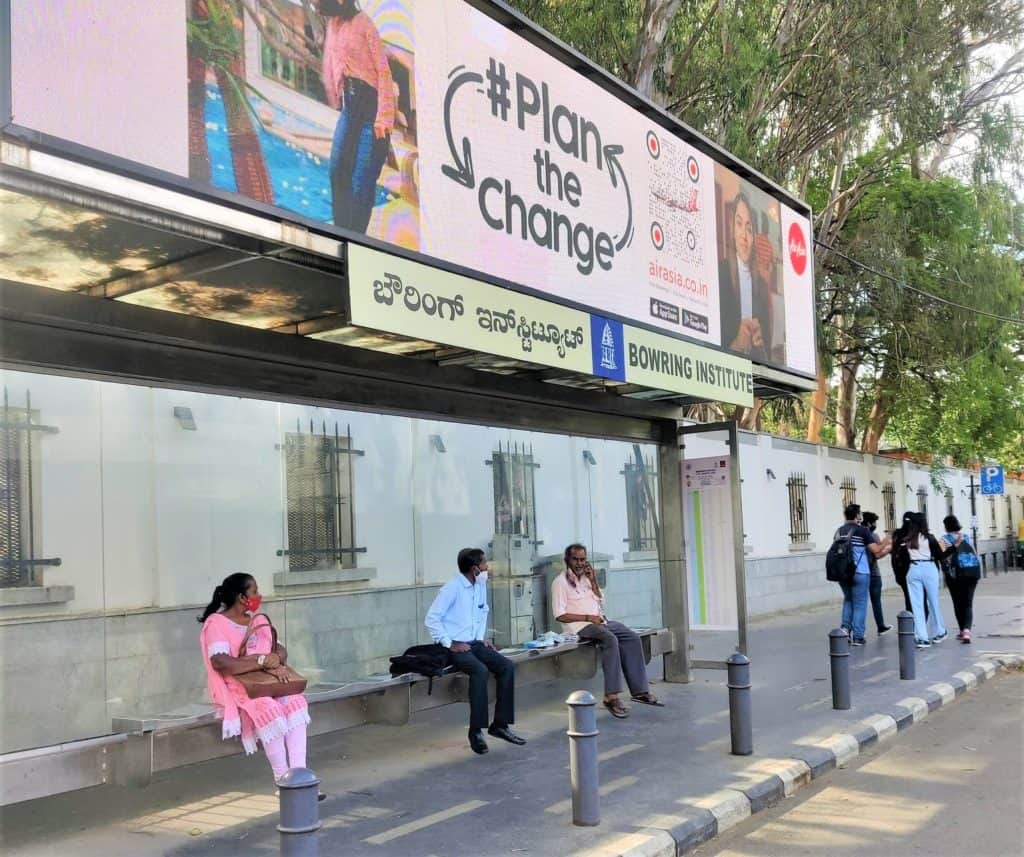This January, as part of a larger programme to make all bus travel free, Boston city set aside eight million dollars to introduce free bus travel on certain routes. Making bus travel free was first tried out in US in the 1970s. The idea caught on and by 2017, 96 such programmes have been recorded globally. In India, Delhi has presently made free bus travel free for women.
Can Bengaluru think along similar lines? The city’s bus network BMTC (Bengaluru Metropolitan Transport Corporation) currently has among the highest fares in the country, making it unaffordable to many. Besides, the city has a huge problem of private vehicles causing traffic congestion and pollution.
Can free travel solve these problems? It will certainly make buses affordable for the poor. But will it attract car users to buses?
According to BMTC’s last published annual report of 2019-20, its annual costs came to Rs 2,669 crore. Given that the government spends large amounts on other public transport like Metro, can it afford to cover this cost by itself through other means?
Free travel is not an easy solution
The technical term for such schemes is ‘fare-free public transport’ (FFPT), meaning the government or a third party would have to cover the cost of making travel free.
But do these schemes yield the desired results?
Read more: How a low-income community in Bengaluru used data to demand a bus route
Most cities that have implemented FFPT schemes are small and medium sized. Many of them did show increased passenger numbers after the scheme was implemented. But most of the new travellers were pedestrians, cyclists and those already using public transport. Despite these cities simultaneously investing to improve service quality, only a small proportion of car users shifted to buses, according to a 2020 policy brief by the UITP (International Association of Public Transport).
For example, in Hasselt in Belgium, passenger numbers increased by seven times, from 1,000 to 7,000 per day, when FFPT was first introduced in 1997. The goal was to reduce traffic congestion in the city centre. But, 63% of the new passengers comprised former bus users and 21% by cyclists and pedestrians combined. Only 16% of the new passengers were car users. This was despite Hasselt also introducing car-restrictive measures (like reducing parking spaces).
One of the biggest ongoing FFPT schemes is in Tallinn in Estonia, a city with a population over four lakh. Tallinn introduced free travel in buses, trams and trolleys exclusively for its residents in 2013. A study a year later, showed that fare removal had accounted for just 1.2% of increase in passenger numbers (possibly because the city already had high public transport usage plus free travel for certain categories). While simultaneous service improvements – increasing network coverage area and vehicle frequency – increased passenger numbers by another 1.8%.
In Tallinn too, the new passengers were mostly cyclists and pedestrians, rather than car users. In effect, the scheme did help low-income groups, but did not tempt car users to shift to buses.

Ravi Gadepalli, independent consultant and public transport specialist, says it’s important to look at the reasons why a city introduces FFPT. “Tallinn did it because its people were increasingly moving to the suburbs,” says Ravi. “So they introduced a host of measures like reducing property tax and free public transport, to attract more people to the city and increase economic activity”.
In fact, in Tallinn, the FFPT scheme prompted a large number of people to register as residents of the city, and the tax revenue from them largely covered the costs of the scheme.
In small cities like Hasselt, the FFPT scheme was aimed at increasing ridership in the highly underutilised public transport systems. In these cities, the fare revenue anyway covered only a small part of the bus network’s operating costs, and this amount could be easily recovered from other sources, says the UITP brief. For example, in the French city of Dunkirk that implemented FFPT, fares covered just 9% of the operational costs.
This is unlike the case of Bengaluru, where a large number of people already use the bus, and the fares they pay make up the biggest chunk of BMTC’s revenue, Rs 1,807 crore in 2019-20 (around 67% of its annual costs).
Ravi Gadepalli says that even in Delhi, small surveys have shown that a significant share of the women availing the free bus services are former users of Delhi Metro, which is relatively more expensive. That is, one mode of public transport is capturing users from another, rather than attracting private vehicle users.
He says that introducing the FFPT scheme in Bengaluru will likely help certain groups like garment factory workers who spend 10% or more of their income on commute. “According to research and the National Sample Surveys, typically households prefer to spend 5-8% of their income on transport, and beyond that it becomes unaffordable”.
However, the majority of BMTC users are able and willing to pay, and making travel free for them will only worsen the condition of the cash-strapped BMTC. “Already transport corporations are going to the government every year requesting funds to replace old buses, augment services, etc,” points out Ravi. “In the past five years, with increasing congestion on the roads, BMTC buses have been running fewer kilometers, services are declining, and users are deserting buses. In this scenario, if transport is made free, BMTC will have to depend on government funding just to sustain its operations, which will directly hit the quality of services. This will further accentuate the decline in ridership.”
Besides, even if no fares are collected, BMTC would still need to deploy conductors to issue free tickets to measure passenger numbers, so as to collect reimbursement from the government, Ravi adds. So, BMTC’s costs itself would not reduce with free transport.
Free travel for some target groups may be an option
In a public meeting held by the bus users’ forum Bengaluru Bus Prayanikara Vedike (BBPV) this February, many citizens testified that bus commute was unaffordable or inaccessible to them. Lakshmi, a pourakarmika, said that she spends Rs 1,050 on the bus pass every month, which is too high considering her meagre income and household expenses, children’s fees etc. She said she would benefit from free travel. Some women said their daughters had to drop out of schools and colleges owing to the high transport cost and poor bus connectivity.

Dr Ashish Verma, Professor, Transportation Systems Engineering at IISc, says Bengaluru is incurring huge economic and social costs because of the inability of many groups to access and afford bus travel. “These costs are not understood by the government or the people at large,” says Dr Ashish. However, he too believes free transport for all is not the solution. “With free transport, people may take the services for granted. Public transport may then have more nuisance and crowd, rather than those who necessarily need it.”
Dr Ashish instead advocates free travel for select groups–those who cannot afford public transport but are dependent on it for access to education, livelihood or basic services. “The government could subsidise these sections directly. Or the regular bus services can be cross-subsidised by charging more on premium services like Volvo. BMTC could also consider using revenue from other sources like advertisements, fixed assets, etc.,” he says.
Ravi Gadepalli also believes that targeted fare reductions is the way to go. He notes that there are already well-functioning mechanisms to ensure free or subsidised travel for many categories of passengers— students, retired army personnel, etc. Though BMTC had recently introduced a scheme where the government would foot 75% of the bus pass cost of garment factory workers, the scheme has not been quite successful as the factory owners were not keen to pay the remaining 25% as required. Ravi suggests the state government could perhaps cover the entire amount and reimburse BMTC once the employers certify their employees.
Service quality is more important for attracting car users
According to the UITP policy brief, several studies have shown that for public transport users, pricing comes way below other criteria like reliability, punctuality, frequency and comfort. Thus several changes are needed in Bengaluru—planning services in tune with changing travel patterns, providing basic infrastructure like bus stops, real-time information, more AC buses, etc.

However, with BMTC running at a loss, finding the funds for these measures is a challenge. For example, in 2019-20, BMTC was Rs 549 cr short of covering its operational costs. Vivek Vaidyanathan, an urban expert, says that BMTC needs sustained infusion of capital from the government to help them leapfrog to provide good-quality services.
Read more: Govt support is the only way BMTC can survive COVID: Experts
Further, BMTC would have to demonstrate fiscal prudence, so as to have the flexibility to reduce fares or run more services in underserved areas. “The government needs to work with BMTC on capacity building in terms of managing money and generating revenue from various sources,” says Vivek. (BMTC owns untapped assets including large land parcels, for example.) “Once BMTC is able to build up its financial reserves and demonstrate that it is fiscally prudent, they would be able to get loans from the government or international lending agencies. Then they would be able to do much more”.